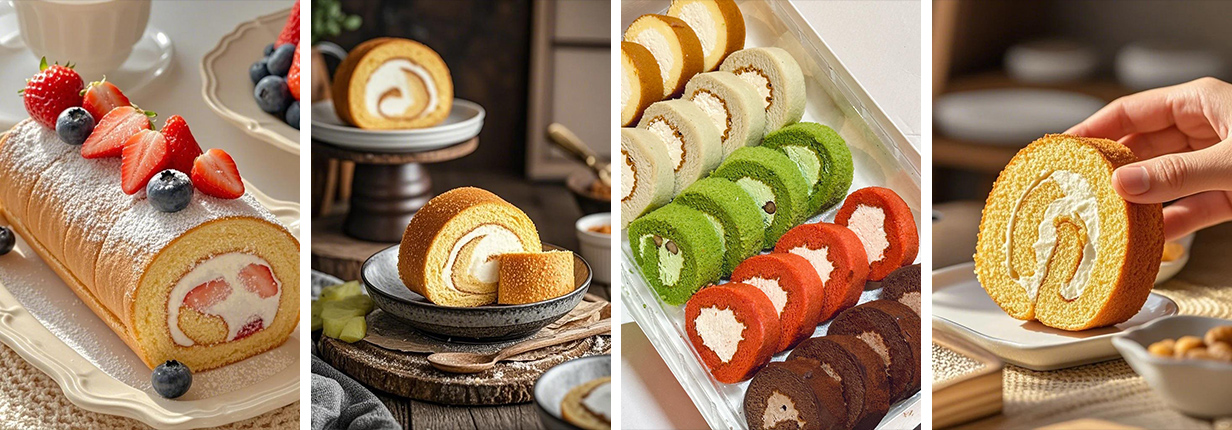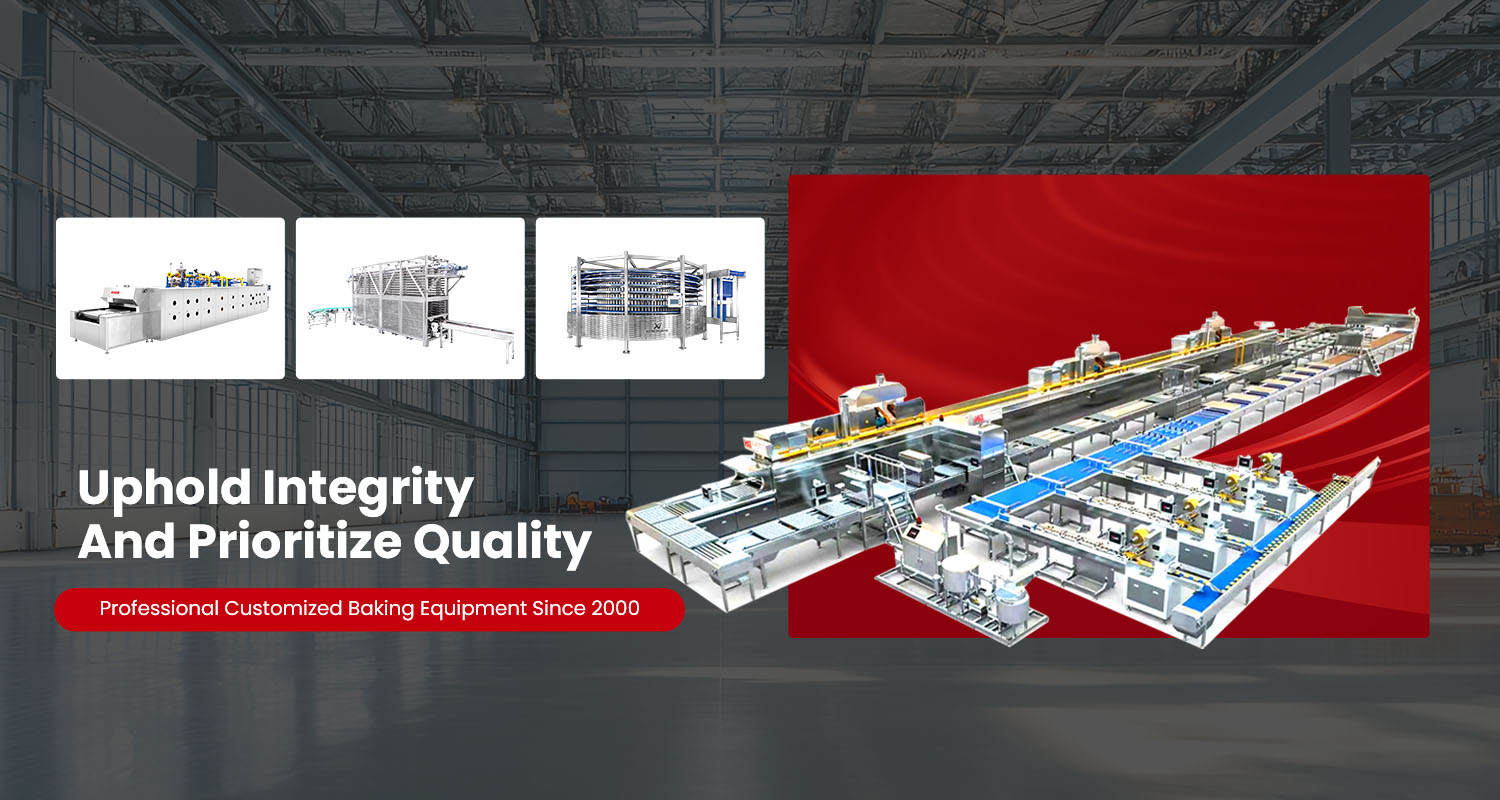Industrial Production Process to Swiss Roll
The Swiss Roll is a beloved dessert that has captured the hearts of many with its delightful combination of a soft, moist sponge cake and a variety of delicious fillings such as cream, jam, or fruit purées. Despite its name, the Swiss Roll did not actually originate in Switzerland but was popularized in the 19th century in Britain and has since spread worldwide. Today, it is available in a wide range of flavors, including original, chocolate, matcha, and fruit, each offering a unique taste experience.

Industrial Production Process of Swiss Roll
1. Ingredient Mixing & Whipping
The first step in the industrial production of Swiss Roll is the mixing and whipping of ingredients. An automatic mixer equipped with turbine-style mixing blades is used to rapidly blend eggs, flour, sugar, oil, and other essential ingredients. This ensures that the batter is uniform and free of lumps, providing a consistent base for the sponge cake.
Aeration is a crucial part of this process. A wolf-tooth-style whipping head is employed to cut and aerate the batter. This specialized tool introduces air into the mixture, creating a fine, fluffy texture that is characteristic of high-quality sponge cakes. The result is a light and airy batter that will bake into a soft and moist cake.
2. Batter Depositing & Baking
Once the batter is ready, it is deposited onto oiled steel belts using a steel belt depositor. This machine evenly pours the batter onto the belts, ensuring that each sheet of cake is of uniform thickness. The steel belts then feed the batter into a gas or electric tunnel oven.
A typical tunnel oven used in this process might be 30 meters long, with a baking time of around 7 minutes. This setup can produce an impressive output of up to 600 kilograms of cake per hour. Temperature control is managed by a PLC (Programmable Logic Controller) system, which intelligently adjusts the upper and lower heating zones to ensure even browning and a soft texture throughout the cake.
3. Cooling & Flipping
After baking, the cake sheets need to cool down before they can be processed further. This is achieved using a return conveyor system, where the baked cake sheets are transported on mesh belts. The cooling process is essential to prevent the cake from sticking together or becoming too soft to handle.
Once cooled, the cake sheets are automatically flipped to prepare them for the next stage of production. This flipping process ensures that the cake is ready to receive the fillings and be rolled into the characteristic Swiss Roll shape.
4. Filling & Rolling
The next step involves filling the cake sheets. A filling injector is used to cut the cake sheets longitudinally and inject the desired fillings, such as cream or jam. Some industrial systems feature dual filling systems, allowing for quick and easy flavor switching to produce a variety of Swiss Roll flavors in a single production run.
After the filling is injected, an automatic roller takes over. This machine uses a flipping device to tightly roll the cake into the familiar Swiss Roll shape. The rolling process is carefully controlled to ensure that the rolls are uniform in size and shape, and that the filling is evenly distributed throughout the roll.
5. Cutting & Portioning
Once the cake has been rolled, it needs to be cut into individual portions. This is done using an ultrasonic cutter, which features titanium blades that vibrate at a high frequency. This technology allows for precise cuts, ensuring that each roll is of uniform size and shape. For example, a model like the UFM3100L can cut up to 1,200 rolls per hour, with a thickness tolerance of just 0.2 millimeters.
A cross-cutting unit is then used to adjust the slice sizes, allowing for the production of both single rolls and sliced portions. This flexibility is important for meeting different market demands and packaging requirements.
6. Sorting & Packaging
The final stage of the production process involves sorting and packaging the Swiss Rolls. A sorting line, such as the SC-S3 one-to-three system, automatically aligns and distributes the rolls at a rate of 80 to 150 packs per minute. This ensures that the rolls are neatly arranged and ready for packaging.
A full auto-packager then takes over, performing tasks such as box opening, loading, and sealing. For example, a TCZB-600W pillow packer with hot-melt glue sealing can efficiently package the rolls into individual or multi-pack boxes, ready for distribution.
Key Equipment & Output
The industrial production of Swiss Roll relies on several key pieces of equipment, including mixers, steel belt ovens, filling injectors, ultrasonic cutters, and sorting/packaging lines. These machines work together to ensure a smooth and efficient production process.
A typical production line can achieve a capacity of 6 to 10 tons of Swiss Roll per day. This high output is essential for meeting the mass-market demand for this popular dessert.
Conclusion
The Swiss Roll is a perfect blend of traditional baking techniques and modern automation. The industrial production process ensures that each roll is made with precision and consistency, maintaining the high quality and delicious taste that consumers expect. This automated production process is ideal for chain bakeries or central kitchens, allowing them to produce large quantities of Swiss Rolls efficiently and reliably. Whether enjoyed as a single roll or in a multi-pack, the Swiss Roll remains a timeless favorite for dessert lovers around the world.






